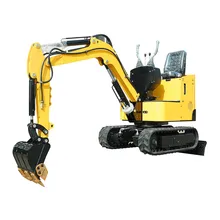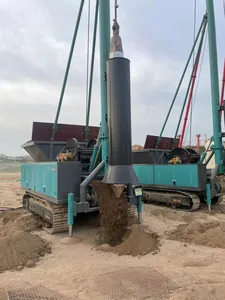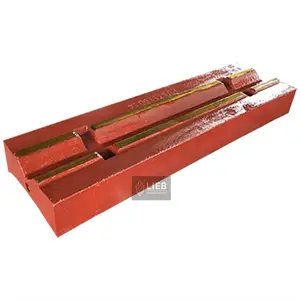Top categories

Engineering & Construction Machinery

Energy & Mineral Equipment

Building Material Machinery

Used Machinery
About products and suppliers
What are Rammers
Rammers, also known as tamping rammers, jumping jacks, or foot compactors, are construction tools designed for compacting cohesive soils, such as clay or silt, in confined areas or next to structures where other compaction equipment like rollers cannot reach. Ideal for trench work, backfill, and foundation work, rammers are essential for creating a solid base that can support structures or pavements.
Powered by either a gasoline engine or an electric motor, rammers deliver a high impact force through a foot or shoe at the bottom of the machine that jumps up and down at a rapid pace. The repetitive percussive force not only compacts the soil but also expels air pockets within the soil structure, ensuring a dense and stable ground. This is particularly crucial in preventing future settling and potential damage to any structures that rest on the compacted area.
The design of rammers incorporates an upright handle and control systems for the operator to guide the machine effectively. The compact nature of these tools makes them maneuverable in tight spaces and efficient in achieving the desired compaction depth. With various models available on the market, rammers cater to different project sizes and soil conditions, ensuring that construction professionals can select a tool that aligns with their specific requirements.
Types of Rammers
The construction industry benefits from an array of rammers tailored to suit various soil types and job site conditions. Here’s a closer look at the common varieties:
Electric Rammers: These are environmentally friendly options that eliminate emissions and reduce noise levels. They are ideal for indoor use or in urban areas where noise and exhaust restrictions are in place.
Gasoline-Powered Rammers: Known for their portability and power, gasoline rammers are widely used in outdoor applications where electricity may not be readily available. They are suitable for compacting cohesive soils in trenches, around foundations, and other confined spaces.
Diesel-Powered Rammers: Similar to their gasoline counterparts but typically offering more torque and longer operational life, diesel rammers are suitable for heavy-duty compaction tasks. They're favored for their fuel efficiency and robust performance.
Each of these types serves common use cases like creating solid foundations for buildings, preparing the ground for roadways or pathways, or compacting soil around utility pipes.
How to Choose Rammers
Selecting the right rammer is pivotal to achieving optimal compaction efficiency while ensuring cost-effectiveness. As businesses primarily involved in B2B transactions contemplate their choices on Alibaba.com, several considerations come into play:
Power Source: Identify whether an electric, gasoline, or diesel model best suits your job site needs in terms of power availability and environmental considerations.
Soil Type: Cohesive soils typically require a rammer's percussive action for proper compaction. Assessing the soil type will guide you toward a rammer with the appropriate impact force.
Job Site Conditions: The size of the area needing compaction and accessibility constraints will determine if you need a more lightweight and maneuverable model or one with greater weight and impact force.
After-Sales Service: Look for suppliers who provide comprehensive after-sales service such as video technical support or engineers available to service machinery overseas.
By factoring these elements into your decision-making process on Alibaba.com, you'll find a rammer well-suited to your business's operational requirements.
Best Rammers on Alibaba.com
Alibaba.com is renowned for its extensive selection of industrial equipment including rammers which cater to businesses worldwide. With a broad assortment of options available from various suppliers globally, customers can find rammers that meet their specific construction needs. Whether looking for electric models suitable for indoor use or powerful diesel-powered options for extensive outdoor projects, Alibaba.com presents an array of choices that align with your business objectives.
The platform's user-friendly interface simplifies the process of comparing different models, assessing unique selling points like high operate efficiency or low maintenance costs, and selecting features such as customized support including OEM or ODM. This level of customization ensures that companies can acquire equipment tailored to their project demands.
Furthermore, Alibaba.com enhances buyer confidence through its Trade Assurance service, safeguarding payments until delivery is confirmed. With easy mobile access and multilingual communication tools, Alibaba.com stands out as a convenient marketplace that supports businesses in sourcing quality construction machinery like rammers efficiently and reliably.
Common FAQs for Rammers
What are the key differences between electric, gasoline, and diesel rammers?
Electric rammers typically offer the benefits of lower noise levels and zero emissions, making them suitable for indoor or urban use. Gasoline rammers provide portability and ease of use in areas without electric power access. Diesel rammers are known for their durability and higher torque, ideal for heavy-duty compaction tasks.
How do I determine the right rammer for my soil type?
Consider the soil's cohesiveness. Rammers are most effective on cohesive soils like clay and silt. For non-cohesive soils like sand or gravel, a plate compactor may be more suitable. Ensure the rammer you select can deliver sufficient impact force for the soil conditions on your job site.
Can rammers be used in confined spaces?
Yes, rammers are designed to be compact and maneuverable, making them ideal for use in trenches, around foundations, and other confined areas where larger compaction equipment cannot reach.
What should I consider regarding after-sales service when choosing a rammer?
Look for suppliers who offer comprehensive after-sales support, including video technical assistance, online support, and availability of engineers for overseas machinery service. This ensures that you will have the necessary support for maintenance and operational queries.
How do I maintain a rammer properly?
Regular maintenance includes checking and cleaning the air filter, changing the oil as recommended by the manufacturer, inspecting the tamping shoe for wear and tear, and ensuring that all moving parts are properly lubricated. Always refer to the user manual for specific maintenance guidelines.
What safety precautions should be taken while operating a rammer?
Operators should wear appropriate personal protective equipment (PPE) such as safety boots, gloves, ear protection, and eye protection. It's also important to be trained on the proper use of the machine and to ensure that bystanders maintain a safe distance during operation.
Are there any environmental considerations when using a rammer?
Electric rammers offer an environmentally friendly option with no emissions. When using gasoline or diesel rammers, consider the impact of exhaust emissions and noise pollution on your work environment, especially in urban or indoor settings.
Can I use a rammer for non-construction applications?
While rammers are primarily designed for construction applications like compacting soil for foundations or trench work, they can also be used in other industries where ground stabilization is required.
How does compaction depth affect my choice of rammer?
The size of the rammer's foot or shoe and its impact force will determine the compaction depth achievable. Choose a rammer based on the depth requirements of your project to ensure adequate soil compaction.
What unique selling points should I look for in a rammer?
Consider unique selling points such as high operating efficiency, long lifetime, low maintenance cost, easy maintenance features, high power engine options or fully hydraulic systems that can contribute to overall productivity and cost savings.
























 浙公网安备 33010002000092号
浙公网安备 33010002000092号 浙B2-20120091-4
浙B2-20120091-4